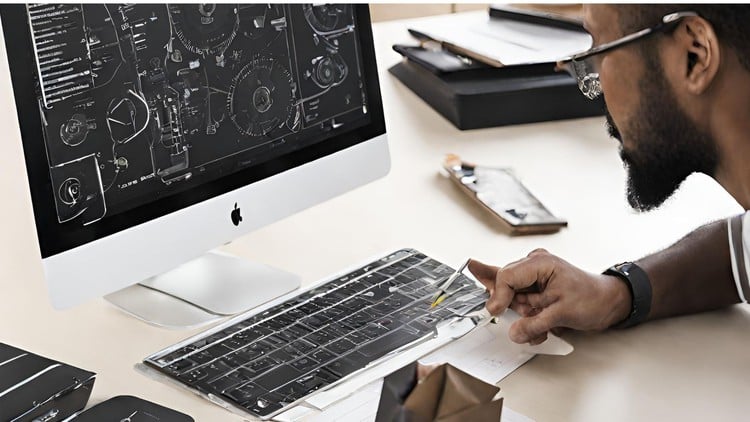
Design career for Mechanical, electrical, electronics, systems and industrial engineering students. JJ/GE Best Practices
⏱️ Length: 4.0 total hours
⭐ 4.46/5 rating
👥 34,248 students
🔄 August 2025 update
Add-On Information:
“`html
Note➛ Make sure your 𝐔𝐝𝐞𝐦𝐲 cart has only this course you're going to enroll it now, Remove all other courses from the 𝐔𝐝𝐞𝐦𝐲 cart before Enrolling!
- Course Overview
- This comprehensive Master’s program is meticulously crafted to equip mechanical, electrical, electronics, systems, and industrial engineering graduates with the essential knowledge and practical skills to excel in the dynamic field of product design, development, and prototyping.
- The curriculum is structured to bridge the gap between theoretical engineering principles and the tangible creation of market-ready products, emphasizing industry-leading best practices and real-world application.
- With a strong focus on innovation and practical execution, students will embark on a transformative journey from initial concept generation to the validation and refinement of functional prototypes.
- The course integrates strategic business thinking with rigorous engineering discipline, preparing students to not only design but also to strategically position their innovations for success in the marketplace.
- Leveraging the insights from proven methodologies, this program ensures participants gain a competitive edge in their chosen engineering disciplines.
- Key Learning Objectives (Beyond Explicitly Stated)
- Strategic Innovation Cultivation: Develop a keen ability to identify unmet market needs and translate them into innovative product concepts that offer a distinct competitive advantage.
- User-Centric Design Ethos: Integrate a deep understanding of end-user behavior, preferences, and pain points into the entire design and development lifecycle, fostering empathy-driven innovation.
- Agile Development Frameworks: Master iterative development cycles and rapid prototyping methodologies that allow for quick learning, adaptation, and risk mitigation throughout the product creation process.
- Design for Manufacturing and Assembly (DFMA) Principles: Learn to conceptualize and design products with a strong emphasis on cost-effectiveness, manufacturability, and efficient assembly, minimizing production complexities.
- Cross-Functional Team Collaboration: Develop the skills to effectively communicate and collaborate with diverse teams, including marketing, sales, and manufacturing, to ensure holistic product success.
- Intellectual Property and Patent Considerations: Gain an introductory understanding of intellectual property rights and the importance of patent considerations during the innovation and development phases.
- Life Cycle Assessment and Sustainability: Explore the integration of sustainable design principles and consider the environmental impact of products throughout their lifecycle, from material sourcing to end-of-life disposal.
- Lean Product Development Strategies: Apply lean principles to minimize waste and maximize value creation in the product development process, focusing on delivering essential features efficiently.
- Market Validation and Feedback Integration: Learn systematic approaches to gather and analyze market feedback, using it to inform design iterations and ensure product-market fit.
- Advanced Materials and Manufacturing Technologies: Explore the application of emerging materials and cutting-edge manufacturing technologies (e.g., additive manufacturing, advanced composites) in product design.
- Requirements / Prerequisites
- A foundational understanding of engineering principles relevant to the student’s specific discipline (Mechanical, Electrical, Electronics, Systems, or Industrial Engineering).
- Familiarity with basic design concepts and problem-solving approaches in an engineering context.
- Access to a computer with internet connectivity for course materials and potential simulation software.
- A willingness to engage in hands-on learning and iterative design processes.
- Skills Covered / Tools Used
- Conceptualization and Ideation Techniques
- Design Thinking Methodologies
- Technical Specification Development
- 3D Modeling and CAD Software (e.g., SolidWorks, Fusion 360 – specific software may vary by case study)
- Basic Prototyping Tools and Techniques (conceptual understanding)
- Data Analysis and Interpretation for Design Improvement
- Project Management Fundamentals
- User Research and Needs Analysis
- Failure Mode and Effects Analysis (FMEA)
- Statistical Process Control (SPC)
- Cost Analysis for Product Development
- Benefits / Outcomes
- Enhanced Employability: Graduates will be highly sought after by companies seeking engineers with a holistic understanding of product creation, from concept to functional prototype.
- Career Advancement: Equip yourself with the skills to transition into roles such as Product Designer, Development Engineer, Prototyping Specialist, Innovation Manager, or R&D Engineer.
- Entrepreneurial Readiness: Gain the confidence and practical knowledge to launch new ventures and develop innovative products for your own business ideas.
- Problem-Solving Prowess: Develop a sophisticated approach to identifying, analyzing, and solving complex engineering challenges in product development.
- Cross-Disciplinary Fluency: Cultivate the ability to effectively communicate and collaborate across different engineering disciplines, fostering integrated product solutions.
- Competitive Edge: Differentiate yourself in the job market with a robust portfolio showcasing your ability to design, develop, and prototype innovative products.
- PROS
- Highly Practical and Application-Oriented: Focuses on tangible outcomes and real-world product creation, making learning immediately applicable.
- Broad Engineering Discipline Applicability: The foundational principles are relevant across multiple engineering fields, offering wide appeal.
- Emphasis on “Winning” Concepts and Prototypes: Directly addresses the goal of creating successful and market-ready products.
- CONS
- Potential for Conceptual Depth Variation: Given the breadth of topics, the depth of coverage for highly specialized advanced engineering concepts might be limited.
“`
Learning Tracks: English,Business,Entrepreneurship
Found It Free? Share It Fast!